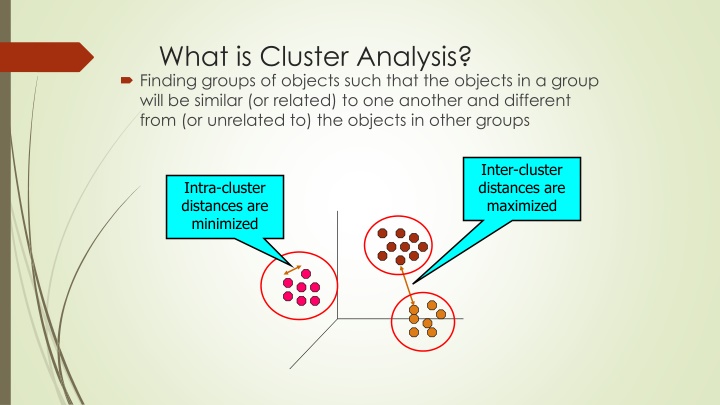
Understanding Cluster Analysis for Grouping Data
Explore the concept of cluster analysis, a method of finding groups of similar objects while maximizing inter-cluster distances and minimizing intra-cluster distances. Discover applications, distinctions, and types of cluster analysis to enhance your data analysis techniques.
Download Presentation

Please find below an Image/Link to download the presentation.
The content on the website is provided AS IS for your information and personal use only. It may not be sold, licensed, or shared on other websites without obtaining consent from the author. If you encounter any issues during the download, it is possible that the publisher has removed the file from their server.
You are allowed to download the files provided on this website for personal or commercial use, subject to the condition that they are used lawfully. All files are the property of their respective owners.
The content on the website is provided AS IS for your information and personal use only. It may not be sold, licensed, or shared on other websites without obtaining consent from the author.
E N D
Presentation Transcript
What is Cluster Analysis? Finding groups of objects such that the objects in a group will be similar (or related) to one another and different from (or unrelated to) the objects in other groups Inter-cluster distances are maximized Intra-cluster distances are minimized
Applications of Cluster Analysis Understanding Group related documents for browsing, group genes and proteins that have similar functionality, or group stocks with similar price fluctuations 1 Discovered Clusters Industry Group Applied-Matl-DOWN,Bay-Network-Down,3-COM-DOWN, Cabletron-Sys-DOWN,CISCO-DOWN,HP-DOWN, DSC-Comm-DOWN,INTEL-DOWN,LSI-Logic-DOWN, Micron-Tech-DOWN,Texas-Inst-Down,Tellabs-Inc-Down, Natl-Semiconduct-DOWN,Oracl-DOWN,SGI-DOWN, Sun-DOWN Apple-Comp-DOWN,Autodesk-DOWN,DEC-DOWN, ADV-Micro-Device-DOWN,Andrew-Corp-DOWN, Computer-Assoc-DOWN,Circuit-City-DOWN, Compaq-DOWN, EMC-Corp-DOWN, Gen-Inst-DOWN, Motorola-DOWN,Microsoft-DOWN,Scientific-Atl-DOWN Technology1-DOWN 2 Technology2-DOWN 3 4 Fannie-Mae-DOWN,Fed-Home-Loan-DOWN, MBNA-Corp-DOWN,Morgan-Stanley-DOWN Financial-DOWN Baker-Hughes-UP,Dresser-Inds-UP,Halliburton-HLD-UP, Louisiana-Land-UP,Phillips-Petro-UP,Unocal-UP, Schlumberger-UP Oil-UP Summarization Reduce the size of large data sets Clustering precipitation in Australia
What is not Cluster Analysis? Supervised classification Have class label information Simple segmentation Dividing students into different registration groups alphabetically, by last name Results of a query Groupings are a result of an external specification Graph partitioning Some mutual relevance and synergy, but areas are not identical
Notion of a Cluster can be Ambiguous How many clusters? Six Clusters Two Clusters Four Clusters
Types of Clusterings A clustering is a set of clusters Important distinction between hierarchical and partitional sets of clusters Partitional Clustering A division data objects into non-overlapping subsets (clusters) such that each data object is in exactly one subset Hierarchical clustering A set of nested clusters organized as a hierarchical tree
Partitional Clustering Original Points A Partitional Clustering
Hierarchical Clustering p1 p3 p4 p2 p1 p2 p3 p4 Traditional Hierarchical Clustering Traditional Dendrogram p1 p3 p4 p2 p1 p2 p3 p4 Non-traditional Hierarchical Clustering Non-traditional Dendrogram
Other Distinctions Between Sets of Clusters Exclusive versus non-exclusive In non-exclusive clusterings, points may belong to multiple clusters. Can represent multiple classes or border points Fuzzy versus non-fuzzy In fuzzy clustering, a point belongs to every cluster with some weight between 0 and 1 Weights must sum to 1 Probabilistic clustering has similar characteristics Partial versus complete In some cases, we only want to cluster some of the data Heterogeneous versus homogeneous Cluster of widely different sizes, shapes, and densities
